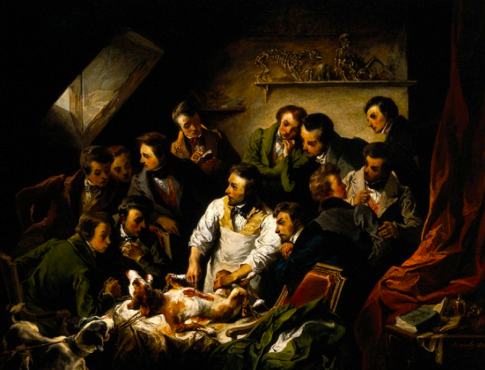By Walter E.
Knowledge of the human body was at an interesting crossroad in Pre- Modern England. After the fall of Rome, little was done towards advancing medical understanding, leaving the English with only Greek traditions of medicine (Kiple 25). It would not be until William Harvey’s discoveries in the late 16th century that a new resurgence of medical research and experimentation would occur. Vivisection on live animals was, at the time, a viable way to test theories of anatomy and determine how certain parts of the body functioned. Animals were seen as tools, and, rather than “wasting” a human life, animals provided a means for decreased distress in cases of failure.To our eyes, pictures and accounts of these experiments come off as cruel torture; however, they would in the end prove crucial to modern understanding of the human body.
Harvey’s discovery of blood circulation, one of the greatest medical discoveries, was based on animal experimentation (Kiple 25). These experimentations would prove crucial to understanding how large amounts of blood moved through the body. Obviously, the same experiment would not yield the same results on a corpse. Even with the death of an animal, the relationship between living and dying would be able to be better understood. Since live animal experimentation involved specific skills and the presence of an audience to confirm any found results, the affirmation of any experiment proved to be crucial since results on animals would vary widely (Guerrini 395). This visual conformation would allow other scientists of the time to look at Harvey’s findings and try to determine their own.
Robert Boyle and Robert Hooke started with similar experiments. Starting with larks, they would pump the air out of the bird until it died. Eventually they would move on to other animals (Guerrini 395). Hooke’s attempt at this process on a dog is well documented. Hooke wrote down accounts of the experiment. Hooke was able to display the dog’s thorax by cutting away the ribs and diaphragm (Hooke 539). The dog was able to last an hour with Hooke pumping air into the lungs with a pair of bellows. Hooke noted that, “upon ceasing this blaft, and fluffering the lungs to fall and lye still, the dog would immediately fall into dying convulsive fits” (Hooke 540). While the correlation between air and lungs seems obvious now, this was a major discovery in human medicine.
Boyle noted that the animals felt distressed. However, he did not linger on the treatment of his experiment animals (Guerrini 397). This disassociation with how the animals felt was one of the many instances where the separation between humans and animals was clear. It is interesting that the purpose for these experiments was to discover how the human body worked, and even if the animals functioned similarly to humans, the separation was still present. What determines the value of human to animal life? If animals functioned in similar ways to humans, then why must there be this constant separation. It could be argued that since these experiments were on animals, then relating them to humans shouldn’t be allowed. However that is not the case. These discoveries found in animals led to the modern understanding of the human body. Even with the lack of attention to the well being of animals and an almost barbaric bout of vivisections, science would not have been able to advance without the presence of these tests. While the argument of what constitutes “human” continued to be challenged throughout the 16th century and beyond, the idea that bodily organs functioned in a universal sense could not.
____________________________________________
Walter is a junior at Ball State University. He studies English with a concentration in creative writing.
____________________________________________
Image: Mouchy, Emile- Edouard. Physiological Demonstration with Vivisection of a Dog. 1832. Wellcome Library, London. The Chirurgeon’s Apprentice. Web. 17 Apr. 2014.
Guerrini, Anita. “The Ethics of Animal Experimentation in Seventeenth Century England.” Journal of the History of Ideas 50.3 (1989): 391- 407. JSTOR. Web. 27 March 2014
Hooke, Robert. “An Account of an Experiment Made by Mr. Hook, of Preserving Animals Alive by Blowing through Their Lungs with Bellows.” Philosophical Transactions (1665- 1678) 2.1 (1666): 539-540.JSTOR. Web. 27 March 2014.
Kiple, Kenneth F, and Kriemhild Conee Ornelas. “Experimental Animals in Medical Research: A History.”Why Animal Experimentation Matters: The Use of Animals in Medical Research. Ed. Ellen Frankel Paul and Jeffery Paul. London: Transaction, 2001. 23-48. Print.

Leave a comment